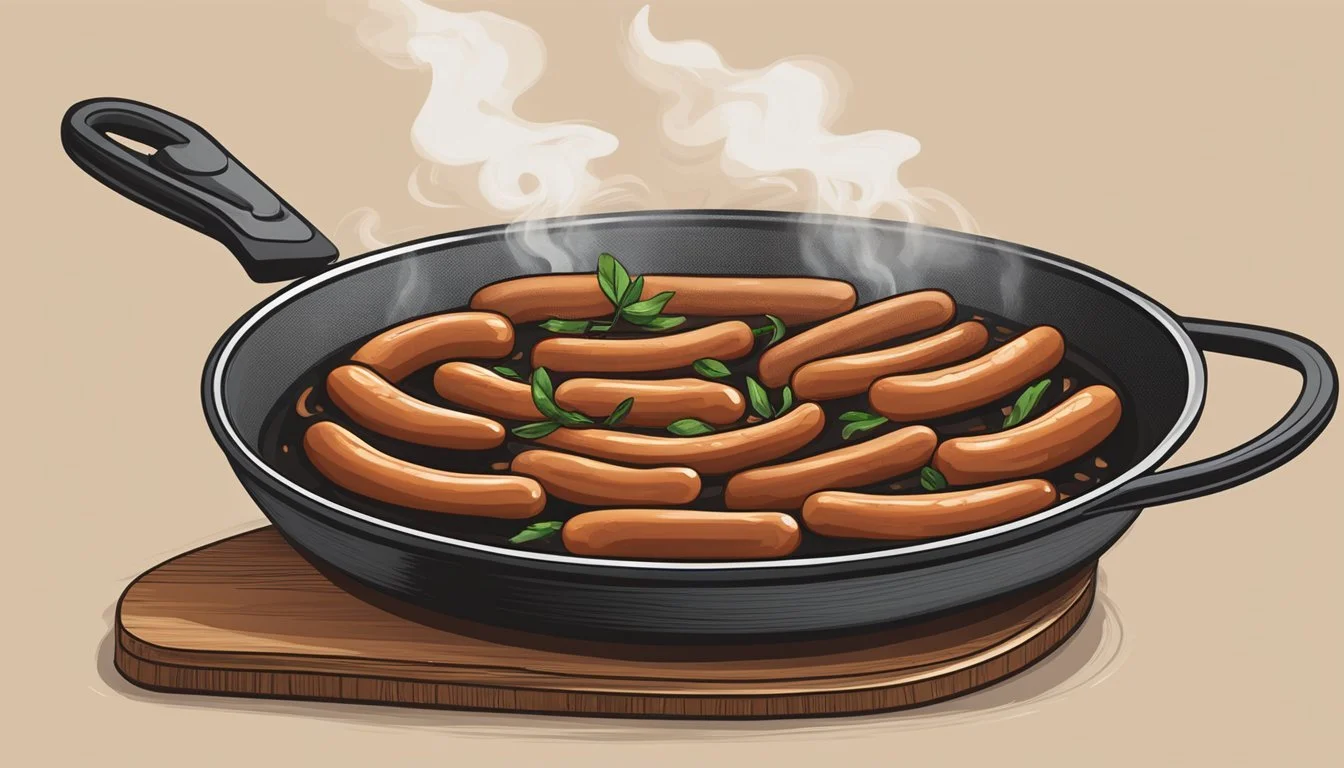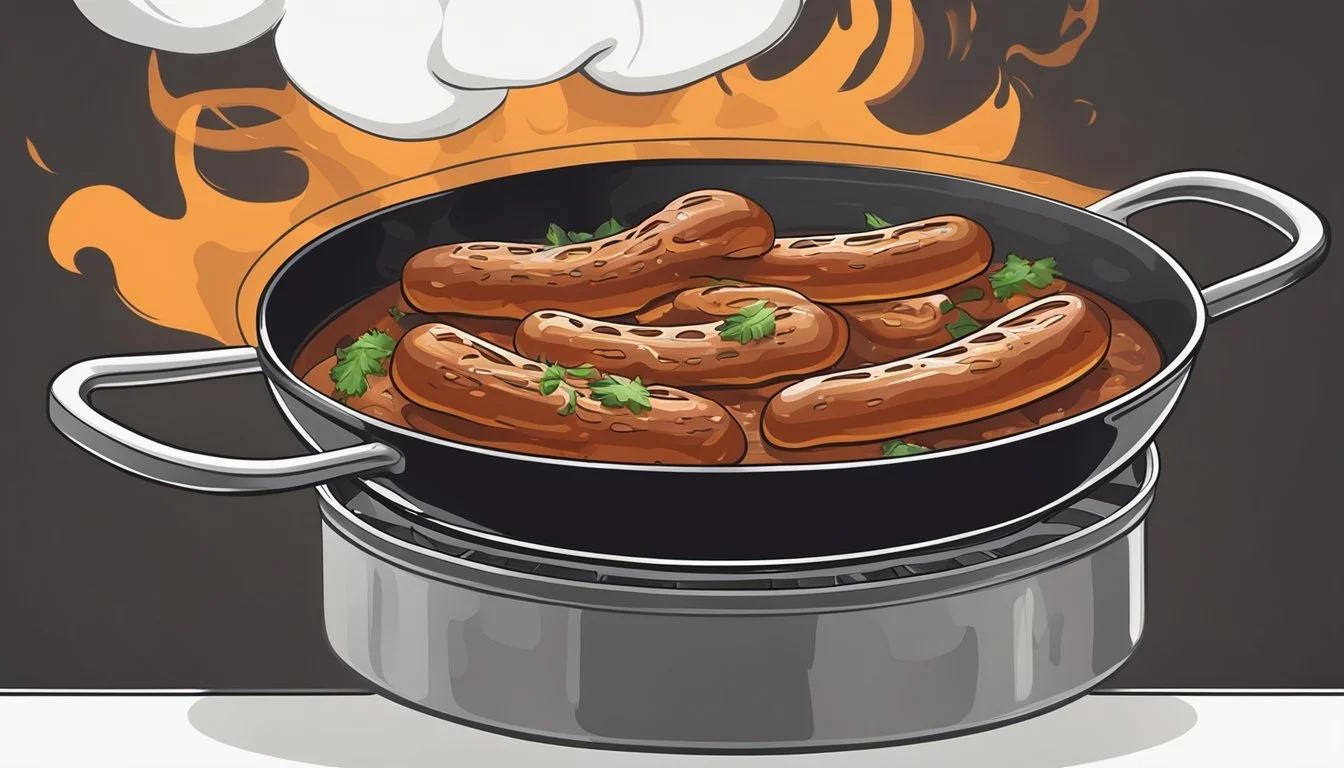Best Way to Reheat Linguica
Tips for Preserving Its Signature Smokiness
Linguica, a Portuguese sausage known for its robust garlicky flavor and smoky finish, has been a staple in various culinary traditions. As with any cooked meat, proper reheating techniques are essential to maintain the quality and flavor profile of the sausage. It's particularly important with linguica to preserve its distinct taste and the smoky essence that sets it apart.
When reheating linguica, the goal is to warm it through to the correct temperature without compromising the moisture and texture that give it its appeal. Whether previously grilled, baked, or fried, linguica requires a gentle reheating method to ensure that the smoky flavor developed during its initial cooking is not lost. Reheating should also aim to achieve a safe consumption temperature while preventing the sausage from becoming dry or overcooked.
Understanding Linguica
Linguica is a type of Portuguese sausage renowned for its robust flavor and versatility in a variety of dishes. It holds a special place within Portuguese cuisine and is cherished for both its taste and cultural significance.
Origins and Culinary Significance
Linguica originated in Portugal and quickly became a staple of Portuguese cuisine. This sausage is traditionally made with pork, seasoned with garlic and paprika, and smoked over wood to achieve its signature flavor. In Portugal and among diaspora communities, linguica is often featured at gatherings and festive occasions, reflecting its importance in social and cultural culinary practices.
Texture and Flavor Profile
The texture of linguica is characteristically firm yet not overly dense. It carries a distinct smoky flavor with a mild to moderate level of spiciness. The smoking process, along with the infusion of garlic and paprika, confers a complex flavor profile that sets linguica apart from other sausages. It expresses the essence of Portuguese culinary tradition through its balance of savory, smoky, and slightly spicy notes.
Proper Storage and Handling
To maintain the quality and safety of linguica, proper storage and handling are essential. In the refrigerator, linguica should be kept in its original packaging until ready to use, or stored in an airtight container after opening. It can typically be refrigerated for several days. To extend its shelf life, linguica can be frozen for up to three months. It is vital to thaw frozen linguica in the refrigerator to prevent the risk of foodborne illnesses. Before reheating, ensuring that the linguica has been stored correctly will help in preserving its smoky flavor and safe consumption.
Reheating Methods Overview
When reheating linguica, preserving its smoky flavor and texture is paramount. The choice of reheating method can significantly affect the quality of the sausage.
Safety and Quality Considerations
When reheating linguica, safety is as important as maintaining quality. Linguica should always be reheated to an internal temperature of 165°F to ensure it's safe to consume. A meat thermometer can be used to check this. To keep the sausage from drying out and losing its characteristic flavor, one must ensure even heat distribution and avoid excessive reheating times.
Comparing Dry Heat and Moist Heat Methods
Both dry heat and moist heat methods have their unique impacts on the texture and flavor of linguica:
Dry Heat: Reheating using methods like an oven or stovetop generally preserves the linguica's smoky taste but may potentially dry it out if not carefully monitored.
Moist Heat: Conversely, heating methods that introduce moisture, like steaming or using a covered pan with a bit of water, can help maintain the sausage's succulence but might slightly dilute its robust flavor.
Tools and Equipment Required
The tools required for reheating linguica efficiently and safely depend on the chosen method:
Oven: An oven set to a moderate temperature, around 325°F, with the linguica wrapped in aluminum foil to lock in moisture.
Stovetop: A non-stick skillet preheated over medium heat, where linguica can be gently warmed with a splash of water or broth to add moisture. Foil can be used to cover the skillet and trap steam.
Microwave: Although not ideal, a microwave can be used for quick reheating. Linguica should be covered with a microwave-safe lid or plastic wrap to retain moisture and heated in short intervals to avoid uneven cooking.
Reheating in the Oven
When reheating linguica in the oven, maintaining its smoky flavor and moisture is paramount. The following steps and tips ensure that the sausage retains its texture and taste as if freshly grilled.
Step-by-Step Instructions
Preheat the Oven: Set the oven to 325°F (163°C) for a gentle reheating process that won't dry out the linguica.
Prepare the Linguica: Place the linguica in an oven-safe dish that will allow it to heat evenly.
Cover with Foil: Seal the dish with aluminum foil to lock in moisture and the smoky flavor.
Tips for Retaining Moisture and Flavor
Retain Moisture: A small amount of water, stock, or beer added to the bottom of the dish can help to keep the linguica moist during reheating.
Utilize Foil: Aluminum foil not only seals in the moisture, but also helps to uniformly circulate the heat.
Avoiding Common Mistakes
Avoid High Temperature: Reheating linguica at a temperature that is too high can cause it to dry out and lose its delicate smoky flavor.
Do Not Overcook: Check the linguica every few minutes. Overcooking can toughen the sausage and diminish its characteristic texture.
Stovetop Reheating
When reheating linguica on the stovetop, the goal is to retain its distinctive smoky flavor while ensuring the sausage is heated through. Proper techniques involve pan grilling with a focus on dry heat application, or simmering in liquids to infuse the linguica with complementary flavors that do not overpower its inherent spice profile.
Pan Grilling Techniques
Pan grilling provides direct heat, which can preserve the linguica's smoky essence and spices, such as garlic and paprika.
Heat the Pan: Preheat a grill pan or skillet over medium heat to ensure even cooking.
Prepare the Linguica: Slice the linguica if desired, which increases the surface area for re-crisping the exterior.
Grilling Process:
Avoid overcrowding the pan to maintain a consistent temperature and to prevent steaming.
Sear each side for 3-4 minutes until the linguica is golden brown and the spices become aromatic.
Simmering in Liquids
Simmering in a flavorful liquid can gently warm the linguica, keeping it moist.
Select the Liquid: Choose a liquid like broth or stock that complements the linguica’s spices and smokiness.
Simmering:
Fill a pan with enough liquid to cover the sausage halfway, enhancing its flavor without diluting it.
Bring the liquid to a light simmer, careful not to boil vigorously as it can cause the linguica to split.
Submerge the sausage, cover, and let it warm through for several minutes using low, gentle heat to steam it back to temperature.
Microwave Reheating
When reheating linguica in the microwave, the objective is to preserve its smoky flavor while maintaining moisture.
Quick and Convenient Method
For a swift reheating process, one should initially place the linguica on a microwave-safe plate. It's advisable to cover the sausage with a piece of plastic wrap to trap steam and prevent the linguica from drying out. Heating the linguica in short bursts on a medium power setting (50%-70% of the microwave's full power) is essential to warm it evenly without overcooking.
Preventing Dryness and Overcooking
A key aspect of keeping linguica moist during microwaving is to harness the power of steam. Using the plastic wrap allows the linguica to reheat in its own moisture, which is crucial for maintaining its characteristic smoky taste. Furthermore, to avoid overcooking, one should carefully monitor the reheating time, checking the linguica after the initial burst, and then reheating in 30-second increments until the desired temperature is reached.
Pairing Linguica with Side Dishes
Selecting the right side dishes enhances the smoky, savory flavor of linguica. From breakfast to dinner (What wine goes well with dinner?), various combinations can be used to create satisfying meals that complement this Portuguese sausage.
Breakfast Combinations
For breakfast, linguica complements a range of traditional dishes. Eggs serve as a classic pairing, with the sausage’s smokiness elevating simple scrambled or fried eggs. In Brazil, a portuguese potato hash can be made by dicing linguica and mixing it with crisp potatoes, onions, and a sprinkle of paprika. This creates a hearty start to the day.
Eggs: Scrambled, Fried
Portuguese Potato Hash: Diced linguica, Potatoes, Onions, Paprika
Lunch and Dinner Pairings
When it comes to lunch and dinner, linguica can balance a variety of robust dishes. A cheesy linguica and potato bake marries the flavors of linguiça with melting cheese and soft potatoes, making a comforting entrée. It can also be sliced and added to a chicken and linguiça sheet pan dinner, introducing a smoky twist to the chicken's milder taste. Moreover, a side of Portuguese rice, with its mixed in tomatoes and peppers, proves a flavorful complement.
Cheesy Linguica and Potato Bake: Linguiça, Cheese, Potatoes
Chicken and Linguiça Sheet Pan Dinner: Chicken, Linguiça slices, Mixed vegetables
Portuguese Rice: Rice, Tomatoes, Peppers, Olives
Stews and Soups
Linguica's robust flavor profile shines in stews and soups. In Portuguese cuisine, linguica is a key ingredient in Caldo Verde, a beloved soup where its smokiness enriches the kale and potato base. Another heartwarming option is adding it to a butternut squash soup, where the linguiça can infuse the squash with an extra layer of flavor. For both soups and stews, the key is to allow the linguica's seasoning to mingle and enhance the dish's overall palate.
Caldo Verde: Linguiça, Kale, Potatoes, Onion
Butternut Squash Soup: Linguiça, Butternut Squash, Onions, Paprika
Incorporating Linguica into Culinary Creations
Portuguese-inspired linguica sausage adds a smoky, spicy kick to various dishes. By experimenting with baking, grilling, and innovative culinary twists, one can elevate the flavor profile of traditional and contemporary recipes.
Baked Dishes
Incorporating linguica into baked dishes ties in hearty flavors with comforting textures. A popular Baked Spaghetti Pie can include slices of linguica, layered with spaghetti and parmesan cheese, then baked to golden perfection. For a rustic touch, a Potato Bake merges the smoky notes of linguica with soft potatoes and rich chicken stock, creating a satisfying ensemble perfect for a family dinner.
Grilled Favorites
When linguica is grilled, it retains its juices and smoky flavors, (What wine goes well with smoky flavors?) making it an essential for outdoor cookouts. One can slice linguica and skewer it with shrimp and jalapeños for a fiery kebab. Or, tuck grilled linguica into a Piri Piri Chicken Sandwich, accentuated by garlic powder and cumin for a Portuguese twist. Grilled recipes both honor the traditional taste of Brazil and satisfy the palates of those seeking bold culinary adventures.
Innovative Twists
Contemporary kitchens are adopting innovative twists on traditional linguica dishes, crafting new culinary creations. Transforming a classic pizza, a Linguica Pizza spotlights slices of spicy sausage atop a rich tomato base, sprinkled with cilantro for freshness. To innovate further, a chef might introduce legumes to the mix, such as beans in a linguica chili topped with hints of cumin and garlic powder, thereby marrying the classic with the modern.
Safety Tips and Considerations
When reheating linguica, one must be mindful of safety to prevent foodborne illnesses and to ensure the preservation of the sausage's smoky flavor. Proper handling and storage of leftovers are critical, as bacterial growth can occur if food is not managed correctly.
Preventing Foodborne Illnesses
Temperature Management: Keep linguica at safe temperatures to prevent bacterial growth. Leftovers should be refrigerated within two hours of cooking and reheated to an internal temperature of 165°F before consumption.
Storage Guidelines: Seal linguica in an airtight container before refrigeration. This practice not only deters bacteria but also preserves the sausage's flavor and moisture.
Safely Thawing and Handling Leftovers
Thawing Process: If linguica was frozen, it should be thawed in the refrigerator, not at room temperature, to maintain a safe temperature throughout.
Prepping for Reheating: Before reheating, shred or slice the linguica if it allows for even warming. Always wash hands thoroughly before and after handling leftovers to avoid cross-contamination.
Advanced Techniques
When reheating linguica, advanced techniques like sous vide can precisely control temperature, preserving the sausage's texture and flavor profile. These methods not only ensure safety by preventing bacterial growth but also help in capturing the essence of the smoky aroma that linguica is known for.
Sous Vide for Precision
Sous vide is a method where leftovers are sealed in a bag and submerged in a water bath at a controlled temperature, usually done with a sous vide machine. For linguica, set the sous vide machine to a temperature of 140°F (60°C) to gently reheat without overcooking.
Temperature Control: A thermometer ensures the water bath maintains the ideal temperature, essential for even reheating.
Texture Preservation: The gentle heat keeps the linguica's texture intact.
Safety: The maintained temperature prevents bacterial growth, making sous vide a safe option for reheating.
To use sous vide for reheating linguica:
Place the linguica in a food-safe bag.
Remove the air and seal the bag.
Set the sous vide machine to the desired temperature.
Submerge the bag in the water bath.
Allow sufficient time for reheating—usually around 30 minutes for slices.
Restoring Smoky Aromas
To enhance the smoky flavor that might have diminished in leftovers, one can introduce additional aromas during the reheating process:
Apple Juice: A small amount of apple juice in the bag with the linguica adds a subtle touch that complements smoky meats.
Flavor Profile: Use natural smoke flavor or a pinch of smoked paprika to the bag to further accentuate the linguica’s inherent flavors.
Steps to restoring smoky aromas:
Add a tablespoon of apple juice or desired flavoring to the sous vide bag with the linguica.
Seal the bag, ensuring the flavorings are well-distributed around the sausage.
Proceed with sous vide, allowing the aromas to infuse as the meat reheats.
Preserving and Extending Quality
To maintain the quality of linguica, proper freezing and defrosting techniques are critical, as is reheating that retains its smoky flavor and texture. Adherence to these best practices ensures the sausage remains moist and delicious.
Freezing and Defrosting Best Practices
When freezing linguica, one should wrap it tightly in plastic wrap or foil. Then place it into an airtight container or a heavy-duty freezer bag to prevent freezer burn. The ideal refrigerator temperature for freezing linguica is at 0°F (-18°C) or lower. This preserves its quality.
To defrost, linguica should be taken out of the freezer and placed in the refrigerator, allowing it to thaw gradually. This slow process helps maintain the sausage's texture and moisture. It is not recommended to thaw linguica at room temperature as it can compromise the quality and safety of the food.
Reheating Without Compromising Taste
When reheating linguica, one must take care not to lose its signature smoky flavor or alter its texture. Here are the steps for successful reheating that preserves its qualities:
Preheat: Heat the oven to 350°F (175°C).
Preparation: Transfer linguica to an oven-safe dish, potentially adding a teaspoon of water to provide moisture.
Cover: Use aluminum foil to cover the dish loosely, which helps retain both heat and moisture.
Heat: Place in the oven for about 10-15 minutes.
By following these steps, the linguica reheats evenly without drying out, offering a satisfying culinary experience upon serving.
Conclusion
Reheating linguica properly is crucial for preserving its distinctive smoky flavor and texture. This section recaps the essential methods and offers final guidance to ensure the linguica retains its quality.
Summary of Key Points
Reheating techniques: It is important to select a reheating method that does not compromise the linguica's smoky flavor profile. The use of an oven or stovetop is recommended.
Oven method: Preheating the oven to 350°F (175°C) and reheating the linguica for about 15 minutes helps maintain its texture and flavor.
Stovetop method: A skillet reheating on medium heat for approximately 3-4 minutes on each side will keep the linguica crisp and flavorful.
Final Recommendations
Consistency: The outcome should always offer a balance between a crisp exterior and a juicy interior.
Avoid overcooking: Overheating can dry out the sausage, impairing both texture and flavor. Monitoring the linguica while reheating is crucial.
In recipes: When linguica is part of a recipe, one should ensure that the reheating process does not affect the other components negatively.
This careful approach to reheating will ensure that the linguica contributes its best qualities to any meal, be it within various recipes or enjoyed on its own.






